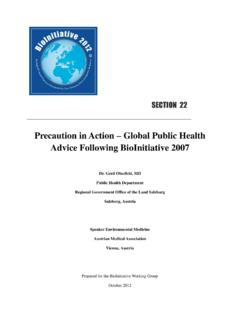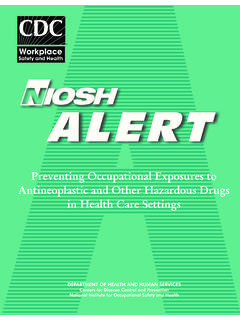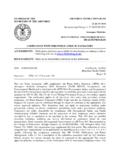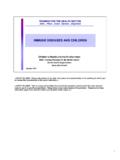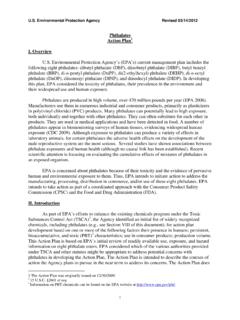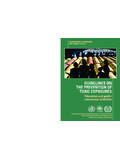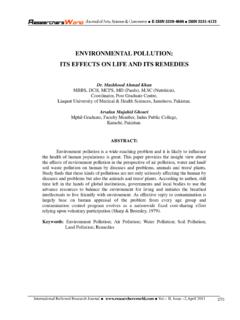Transcription of RESEARCH REPORT 130 - Health and Safety Executive
1 HSE Health & Safety Executive Occupational and environmental exposure to bioaerosols from composts and potential Health effects -A critical review of published data Prepared by The Composting Association and Health and Safety Laboratory for the Health and Safety Executive 2003 RESEARCH REPORT 130 HSE Health & Safety Executive Occupational and environmental exposure to bioaerosols from composts and potential Health effects -A critical review of published data J R M Swan, A Kelsey and B Crook Health and Safety Laboratory Broad Lane Sheffield S3 7HQ E J Gilbert The Composting Association Avon House Tithe Barn Road Wellingborough Northamptonshire NN8 1DH The primary objective of this study was to critically review published literature related to studies of airborne micro-organisms or their constituent parts (bioaerosols)
2 Associated with organic waste composting facilities, and to establish whether there is a risk to worker Health from the inhalation of these bioaerosols. The review aimed to identify the personnel at risk on compost sites, identify the circumstances which increased the risk and indicate suitable control measures to control the risk. A further consideration was that airborne dispersal of bioaerosols from compost facilities could affect neighbouring facilities or residents, leading to Health concerns, and the review also looked at evidence of bioaerosol dissemination from sites, potential exposures and reported ill Health .
3 Further objectives were to review computational modelling tools for estimating dispersion of bioaerosols from composting facilities and to recommend suitable models. Existing experimental data, previously derived from environmental sampling at composting sites by the Composting Association who collaborated on this project, were re-examined to provide comparison between experimental and modelled data. This REPORT and the work it describes were funded by the Health and Safety Executive (HSE).
4 Its contents, including any opinions and/or conclusions expressed, are those of the authors alone and do not necessarily reflect HSE policy. HSE BOOKS Crown copyright 2003 First published 2003 ISBN 0 7176 2707 1 All rights reserved. No part of this publication may be reproduced, stored in a retrieval system, or transmitted in any form or by any means (electronic, mechanical, photocopying, recording or otherwise) without the prior written permission of the copyright owner. Applications for reproduction should be made in writing to.
5 Licensing Division, Her Majesty's Stationery Office, St Clements House, 2-16 Colegate, Norwich NR3 1BQ or by e-mail to ii CONTENTS 1 Introduction 1 7 Reported studies of bioaerosols generated by composting activities and potential human exposure 2 Purpose of the Review 3 3 Composting Practices 7 4 Microbiology of the composting process 10 5 Bioaerosol components and hazard to human Health 14 6 potential ill Health effects among compost workers 21 23 8 Ambient bioaerosol levels, bioaerosols from other industries and dispersal 9 potential use of computational modelling to estimate bioaerosol dispersion from compost sites 32 from composting 42 10 Reports of Ill Health associated with exposure to compost bioaerosols 55 11 Discussion and conclusions 66 12 Summary and recommendations for further study 73 13 Appendices 77 14 References 95 iii iv Executive SUMMARY OBJECTIVES The primary objective of this study was to critically review published literature related to
6 Studies of airborne micro-organisms or their constituent parts (bioaerosols) associated with organic waste composting facilities, and to establish whether there is a risk to worker Health from the inhalation of these bioaerosols. The review aimed to identify the personnel at risk on compost sites, identify the circumstances which increased the risk and indicate suitable control measures to control the risk. A further consideration was that airborne dispersal of bioaerosols from compost facilities could affect neighbouring facilities or residents, leading to Health concerns, and the review also looked at evidence of bioaerosol dissemination from sites, potential exposures and reported ill Health .
7 Further objectives were to review computational modelling tools for estimating dispersion of bioaerosols from composting facilities and to recommend suitable models. Existing experimental data, previously derived from environmental sampling at composting sites by the Composting Association who collaborated on this project, were re-examined to provide comparison between experimental and modelled data. MAIN FINDINGS Detailed information was retrieved on levels of bioaerosols associated with composting, although many composting studies focussed on environmental emissions and the potential risk to sensitive receptors, , persons susceptible to ill Health in the nearby vicinity, rather than occupational exposure.
8 There is limited information available on workers personal exposure to bioaerosols associated with specific tasks in composting, and few studies have described controls used. Data that have been reported indicate that workers at compost sites are at risk of regular exposure to bioaerosols between 10 and 1,000 times greater in concentration than may be expected normally in ambient air. The allergenic fungus Aspergillus fumigatus is a significant component of compost bioaerosol. In waste handling, as in other industries where workers may be exposed to large concentrations of organic dust, there is reported evidence mainly from studies in mainland Europe of raised levels of antibodies and inflammatory mediators associated with compost handling.
9 Also as with other industries where workers are exposed to organic dust, there is the potential for progressive respiratory ill Health with continued high exposure. As composting on a major scale is a relatively new and rapidly expanding industry and symptoms of chronic ill Health may not yet have had time to develop, there may be justification in long term Health monitoring of workers. Only two published case studies reported evidence of respiratory infection, such as allergic bronchopulmonary aspergillosis, one from USA and one from mainland Europe.
10 Concern has been raised by residents in the vicinity of composting sites that composting activities could increase levels of bioaerosols, such as airborne Aspergillus fumigatus spores. Most reports show numbers to have declined to background within 200 m from a compost bioaerosol source, although some REPORT levels above background at greater distance. Background or typical ambient bioaerosol levels may differ by orders of magnitude depending on location, weather and season, which hinders interpretation.










